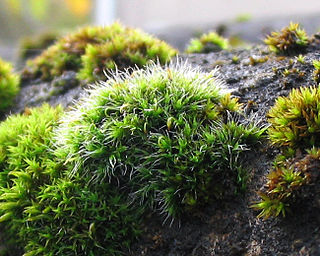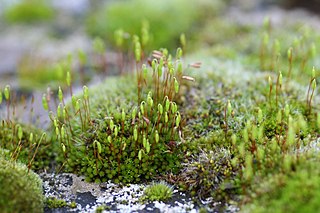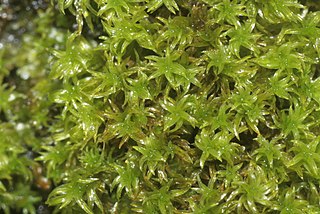
Andreaeaceae is a family of mosses which includes two genera, Andreaea, containing about 100 species, and the genus Acroschisma. The Andreaeaceae prefer rocky habitats ranging from tropical to arctic climates, on which they form tufted colonies, typically with reddish to blackish shoots. The capsules lack the peristome mechanism and dehisce longitudinally to release the spores, resulting in a paper-lantern appearance.

Funariales is a monotypic order of mosses that are acrocarpous.

Grimmiales is an order of mosses in the subclass Dicranidae. It comprises four families: Grimmiaceae, Ptychomitriaceae, Seligeriaceae, and Saelaniaceae.
Acritodon is a genus of moss in the family Hypnaceae.
Aschisma kansanum is a species of moss in the family Pottiaceae. It is endemic to the United States. Its natural habitat is temperate grassland. It is threatened by habitat loss.

Brymela tutezona is a species of mosses in the family Pilotrichaceae. It is endemic to Panama. Its natural habitat is subtropical or tropical moist lowland forests. It is threatened by habitat loss.

Pottiales is an order of mosses in the subclass Dicranidae.
Jaffueliobryum is a genus of moss in family Ptychomitriaceae.
Lepidopilum grevilleanum is a species of moss in the Pilotrichaceae family. It is endemic to Ecuador. Its natural habitat is subtropical or tropical moist lowland forests. It is threatened by habitat loss.
Leucoperichaetium eremophilum is a species of moss in the Grimmiaceae family. It is endemic to Namibia. Its natural habitat is subtropical or tropical dry shrubland. It is threatened by habitat loss.
Mamillariella geniculata is a species of moss in the family Leskeaceae. It is endemic to Russia, where it is an endangered species known from only five to seven locations in the Russian Far East. It grows in deciduous forest habitat which is threatened by development.
Renauldia lycopodioides is a species of moss in the family Pterobryaceae. It is endemic to Tanzania, where it is known from only two locations and is considered an endangered species. It grows on tree branches in forested habitat. It is threatened by deforestation.
Taxitheliella richardsii is a species of moss in the family Pylaisiadelphaceae. It is endemic to Borneo where it is confined to Sarawak. Its natural habitat is subtropical or tropical dry forests. It is threatened by habitat loss.
Taxitheliella is a genus of moss in family Pylaisadelphaceae.
Oedipodium is the only genus of moss in the family Oedipodiaceae. It contains the single species Oedipodium griffithianum, the gouty-moss or Griffith's oedipodium moss. This species is distributed in cooler climates of Eurasia, as well as from Alaska, Washington state, British Columbia, Yukon, Greenland, Newfoundland, Tierra del Fuego and the Falkland Islands.

Bryaceae is a family of mosses.

Zygodon is a genus of moss in family Orthotrichaceae.

Homalia is a moss genus in the family Neckeraceae.
Distichophyllum carinatum is a species of moss in the family Daltoniaceae. It is native to Europe and Asia, where it has a disjunct distribution. It is known to occur in Germany, China, and Japan. It is also known from Austria and Switzerland, but it may be extinct there today. It is very uncommon where it still occurs, growing in only four locations. It is listed as an endangered species by the International Union for Conservation of Nature.

Mniaceae is a family of mosses.









